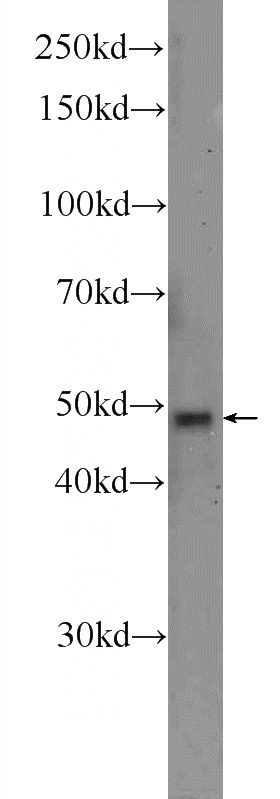-
Product Name
SCRN1 antibody
- Documents
-
Description
SCRN1 Rabbit Polyclonal antibody. Positive WB detected in A549 cells, HeLa cells, mouse brain tissue. Observed molecular weight by Western-blot: 50 kDa
-
Tested applications
ELISA, WB
-
Species reactivity
Human,Mouse,Rat; other species not tested.
-
Alternative names
KIAA0193 antibody; SCRN1 antibody; secernin 1 antibody; SES1 antibody
-
Isotype
Rabbit IgG
-
Preparation
This antibody was obtained by immunization of SCRN1 recombinant protein (Accession Number: NM_014766). Purification method: Antigen affinity purified.
-
Clonality
Polyclonal
-
Formulation
PBS with 0.1% sodium azide and 50% glycerol pH 7.3.
-
Storage instructions
Store at -20℃. DO NOT ALIQUOT
-
Applications
Recommended Dilution:
WB: 1:200-1:1000
-
Validations

A549 cells were subjected to SDS PAGE followed by western blot with Catalog No:115019(SCRN1 Antibody) at dilution of 1:300
-
Background
SCRN genes encode protein members of the secernin family including Secernin 1, Secernin 2 and Secernin 3. Function of Secernin 2 and Secernin 3 are so far not well understood. Secernin 1 is a novel 50-kDa cytosolic protein that appears to be involved in the regulation of exocytosis from peritoneal mast cells. Secernin-1 a novel tumor-associated antigen (TAA) and may be a universal marker of different cancer types including gastric cancer, which has been validated by several researches. Measurement of SCRN1 can be used in the early detection of cancer or in the surveillance of patients who undergo surgery.
-
References
- Chang SH, Jung IS, Han GY, Kim NH, Kim HJ, Kim CW. Proteomic profiling of brain cortex tissues in a Tau transgenic mouse model of Alzheimer's disease. Biochemical and biophysical research communications. 430(2):670-5. 2013.
Related Products / Services
Please note: All products are "FOR RESEARCH USE ONLY AND ARE NOT INTENDED FOR DIAGNOSTIC OR THERAPEUTIC USE"
